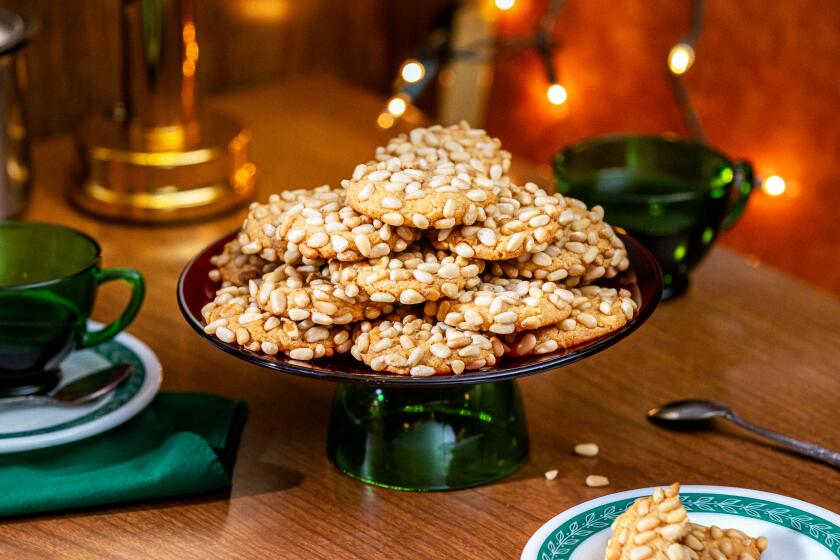Sqirl's Sourdough Scones

This scone dough was created as an all-purpose base for whatever seasonal fruits, spices and other flavorings you want. It’s a great way to use up produce before it goes bad. In that spirit of creativity, Sqirl’s head pastry chef, Catalina Flores, advises you to experiment. Don’t be afraid of odd combinations; to help you get started, we’ve listed some flavor pairings in the Variations below. And adding jam to the scones, a common Flores move, intensifies the flavor of the fruit you’re using but isn’t essential.
If baking plain scones, the dough will seem a little too dry at first, but by the time you bring it together in a disk, it will be the perfect texture. If adding fruit, know that this will make the dough a little wetter and thus stickier to work with, depending on the type you’re using; Add a little extra flour when shaping the dough into a disk if it starts sticking to the surface and work with it quickly. Flores bakes the scones from frozen at Sqirl, and it’s a crucial detail: Freezing them allows the butter to solidify so it puffs the scones quickly once they hit the high heat of the oven; it also helps keep their shape from spreading too much. Once baked, resist the urge to eat the scones while warm, letting them cool completely to attain their characteristic crumbliness.
The whole-grain spelt flour and sourdough starter add wonderful nuttiness and tanginess to the baked scones, so seek out both if you don’t already have them. Spelt flour is available at Whole Foods, most other grocery stores and online, but if you can’t find it, you can substitute it with einkorn, rye or whole-wheat flour. You can make your own sourdough starter, buy some from a local restaurant or online, or ask a friend for some of theirs in exchange for a pan of these scones.
In the bowl of a stand mixer or large bowl, whisk together both flours, the sugar, baking powder, salt and baking soda. Add the spices, if using, and whisk them into the dry ingredients. Add the butter, toss it to coat with the dry ingredients, then place the bowl in the freezer until the butter is well-chilled, 10 minutes.
Meanwhile, in a large liquid measuring cup or small bowl, whisk together the cream, buttermilk, crème fraîche, honey, sourdough starter and citrus zest. Keep the liquid ingredients cold in the refrigerator until you’re ready to use them. Line a large baking sheet with parchment paper.
Place the bowl of dry ingredients and butter on the stand mixer fitted with a paddle and beat on low speed until the butter breaks down to the size of peas, 1 to 2 minutes. (Alternatively, use your fingertips to smash the butter into the dry ingredients repeatedly until the butter breaks down to the size of peas.) Pour in the chilled liquid ingredients and use a fork to gently stir together the two mixtures until they form large clumps of dough. If adding any fresh, frozen fruit or dried fruit, or swirling in jam (see Variations below), stir it in now to evenly mix.
Scrape the dough onto a lightly floured work surface and shape with your hands into a 7-inch-diameter disk, 1 ½ inches thick. Cut the disk into 8 wedges, then arrange the wedges on the prepared baking sheet, spaced evenly apart. Freeze the scones on the baking sheet for at least 30 minutes.
When ready to bake, arrange an oven rack in the center of the oven and heat to 400 degrees. Brush the dough wedges with buttermilk and sprinkle liberally with sugar. Place the baking sheet in the oven and bake, rotating the sheet halfway through baking, until the scones are deep golden brown on the outside, 30 to 32 minutes. Transfer the baking sheet to a wire rack and let the scones cool completely before serving.
Adapted from Catalina Flores, head pastry chef of Sqirl.
Homemade Crème Fraiche
In a small bowl or plastic container, whisk together the cream and buttermilk. Cover with its lid or a sheet of plastic wrap. Let sit in a dark place at cool room temperature for 2 to 3 days to allow the cream to ferment.
Transfer the crème fraîche in its container (or, if using a bowl, pour it into a glass jar with a lid) to the refrigerator and store for up to 2 weeks.
After arranging the cut scones on the baking sheet, in the middle of Step 4, use your index finger knuckle to make a deep divot in the center of each scone. Fill each divot with a heaping 1 teaspoon fruit jam or preserves (don’t use jelly and don’t fill with more or it will spill over the edge of the scone and burn on the baking sheet) then freeze as above. Brush the buttermilk and sprinkle the sugar on the tops of the scones around the jam crater before baking as above.
Swirled Jam Scones
After adding the liquid ingredients, but before the dough just comes together at the end of Step 3, add ½ cup fruit jam or preserves (do not use jelly) and use a large rubber spatula to fold it into the dough until just swirled — do not stir it so much that it completely absorbs into the dough — and proceed with the recipe. Know that this method will cause the dough to be wetter than usual, causing the scones to expand in size as they bake. To help keep them separate, divide the scones between two parchment paper-lined baking sheets, rotating the sheets from top to bottom and front to back halfway through cooking.
Candied Ginger, Lemon and Poppy seed Scones
Whisk 1 tablespoon each poppy seeds and ground ginger into the dry ingredients. Use lemon zest in the dough. Stir 1 cup chopped (¼-inch) candied ginger into the dough immediately following the addition of the liquid ingredients.
Strawberry-Rhubarb Scones
Use orange zest in the dough. Toss ½ cup chopped (¼-inch) rhubarb with ½ teaspoon granulated sugar and let stand for 5 minutes. Stir in ½ cup chopped (¼-inch) frozen strawberries then stir both fruits into the dough immediately following the addition of the liquid ingredients.
Blueberry-Turmeric Scones
Whisk 1 tablespoon ground turmeric in with the dry ingredients. Use orange zest in the dough. Stir 1 cup small or halved, large frozen blueberries into the dough immediately following the addition of the liquid ingredients.
Cherry-Almond Scones
Use orange or lemon zest in the dough. Stir 1 cup chopped (¼-inch) pitted sour cherries and ¼ cup finely chopped toasted almonds into the dough immediately following the addition of the liquid ingredients.
Chocolate Chip Scones
Omit the citrus zest. Stir 1 cup chopped dark chocolate, preferably 60% to 70%, or high-quality bittersweet chocolate chips into the dough immediately following the addition of the liquid ingredients.
Citrus-Honeycomb Scones
When fruit is especially scarce, you can add honeycomb candy to the scone dough, as Flores often does in the winter months because it pairs particularly well with citrus. First, make Crushed Honeycomb Candy. Once cooled, use a spoon to break it into rough 1/2-chunks and measure out half the yield, which is 1 heaping cup; save the remaining honeycomb to eat as is or for another recipe. Use orange zest in the dough. Add the crushed honeycomb and 1/2 cup thinly sliced kumquats or tangerines (including skin and pith, seeds removed) into the dough immediately following the addition of the liquid ingredients.
B: Ideally a majority of the zest should come from an orange-type citrus, like navel oranges, mandarins, tangerines or Cara Cara oranges, but if all you have is lemons, use those — just about any citrus will work here, even grapefruit and lime. Try to pair the zest with whatever fruit and spices you’ll be using to flavor your scones.
C: This fruit is the main flavoring component of your scones, so pick what you like. Better yet, use what you have to use up before it goes bad to stay true to the spirit of these scones. Whole blueberries and raspberries, halved blackberries and chopped strawberries all work well, but since all berries are delicate, spread the chopped berries out on a foil-lined sheet and freeze them for at least 20 minutes first so they hold their shape when mixed into the dough. For all other fruits, just be sure to cut them into 1/4-inch pieces so they incorporate into the dough easily, giving you even amounts of fruit in each bite. Chopped thin-skinned citrus like kumquats, mandarins and tangerines make great candidates in winter, while rhubarb and berries are great in spring. In summer, use any stone fruit like peaches, plums, nectarines or cherries. Cooked quince, chopped apples, pears and persimmons are fantastic in fall. You can also bake these scones plain, with no fruit, and the recipe will work the same.
D: If you don’t have fresh fruit, you can easily use dried in its place; just make sure to chop it into 1/4-inch pieces for even distribution in the dough. Candied ginger, currants, dried apricots and figs all make great additions. Similarly, use nuts in addition to fruit or by themselves. Before mixing into the dough, spread the whole nuts on a baking sheet and toast in a 350-degree oven until fragrant, 8 to 10 minutes. Let cool completely, then finely chop before mixing into the dough.
Get our Cooking newsletter.
Your roundup of inspiring recipes and kitchen tricks.
You may occasionally receive promotional content from the Los Angeles Times.
















